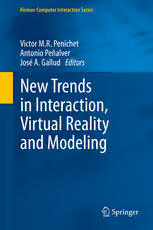Table Of ContentHuman-Computer Interaction Series
Victor M.R. Penichet
Antonio Peñalver
José A. Gallud Editors
New Trends
in Interaction,
Virtual Reality
and Modeling
Human-Computer Interaction Series
Editors-in-chief
JohnKarat
JeanVanderdonckt
Universite´ catholiquedeLouvain,Louvain-la-Neuve,Belgium
EditorialBoard
RavinBalakrishnan,UniversityofToronto,Toronto,ON,Canada
SimoneBarbosa,PUC-Rio,RiodeJaneiro,RJ,Brazil
ReginaBernhaupt,Ruwido,Salzburg,Austria
JohnCarroll,ThePennsylvaniaStateUniversity,UniversityPark,PA,USA
AdrianCheok,CityUniversityLondon,UK
GilbertCockton,NorthumbriaUniversity,NewcastleuponTyne,UK
HenryBeen-LirnDuh,UniversityofTasmania,SandyBay,TAS,Australia
PeterForbrig,Universita¨tRostock,Rostock,Germany
CarlaFreitas,FederalUniversityofRioGrandedoSul,PortoAlegre,RS,Brazil
HansGellersen,LancasterUniversity,Lancaster,UK
RobertJacob,TuftsUniversity,Medford,MA,USA
PanosMarkopoulos,EindhovenUniversityofTechnology,Eindhoven,TheNetherlands
GerritMeixner,HeilbronnUniversity,Heilbronn,Germany
DianneMurray,PuttingPeopleBeforeComputers,London,UK
BradA.Myers,CarnegieMellonUniversity,Pittsburgh,PA,USA
PhilippePalanque,Universite´PaulSabatier,Toulouse,France
OscarPastor,UniversityofValencia,Valencia,Spain
BerylPlimmer,UniversityofAuckland,Auckland,NewZealand
DesneyTan,MicrosoftResearch,Redmond,WA,USA
ManfredTscheligi,CenterforUsabilityResearchandEngineering,Vienna,Austria
GerritvanderVeer,VrijeUniversiteitAmsterdam,Amsterdam,TheNetherlands
ShuminZhai,IBMAlmadenResearchCenter,SanJose,CA,USA
HCIisamultidisciplinaryfieldfocusedonhumanaspectsofthedevelopmentofcomputer
technology. As computer-based technology becomes increasingly pervasive—not just in
developed countries, but worldwide—the need to take a human-centered approach in the
design and development of this technology becomes ever more important. For roughly 30
years now, researchers and practitioners in computational and behavioral sciences have
worked to identify theory and practice that influences the direction of these technologies,
andthisdiverseworkmakesupthefieldofhuman-computerinteraction.Broadlyspeakingit
includesthestudyofwhattechnologymightbeabletodoforpeopleandhowpeoplemight
interactwiththetechnology.TheHCIseriespublishesbooksthatadvancethescienceand
technology of developing systems which are both effective and satisfying for people in a
widevarietyofcontexts.Titlesfocusontheoreticalperspectives(suchasformalapproaches
drawnfromavarietyofbehavioralsciences),practicalapproaches(suchasthetechniques
foreffectivelyintegratinguserneedsinsystemdevelopment),andsocialissues(suchasthe
determinantsofutility,usabilityandacceptability).
Forfurthervolumes:
http://www.springer.com/series/6033
Victor M.R. Penichet (cid:129) Antonio Pe n˜alver
Jose´ A. Gallud
Editors
New Trends in Interaction,
Virtual Reality and Modeling
123
Editors
VictorM.R.Penichet AntonioPen˜alver
ComputingSystemsDepartment CenterofOperationsResearch
UniversityofCastilla-LaMancha UniversityInstitute
Albacete UniversityofElche
Spain Elche,Alicante
Spain
Jose´A.Gallud
ComputingSystemsDepartment
UniversityofCastilla-LaMancha
Albacete
Spain
ISSN1571-5035
ISBN978-1-4471-5444-0 ISBN978-1-4471-5445-7(eBook)
DOI10.1007/978-1-4471-5445-7
SpringerLondonHeidelbergNewYorkDordrecht
LibraryofCongressControlNumber:2013948871
©Springer-VerlagLondon2013
Thisworkissubjecttocopyright.AllrightsarereservedbythePublisher,whetherthewholeorpartof
thematerialisconcerned,specificallytherightsoftranslation,reprinting,reuseofillustrations,recitation,
broadcasting,reproductiononmicrofilmsorinanyotherphysicalway,andtransmissionorinformation
storageandretrieval,electronicadaptation,computersoftware,orbysimilarordissimilarmethodology
nowknownorhereafterdeveloped.Exemptedfromthislegalreservationarebriefexcerptsinconnection
with reviews or scholarly analysis or material supplied specifically for the purpose of being entered
and executed on a computer system, for exclusive use by the purchaser of the work. Duplication of
this publication or parts thereof is permitted only under the provisions of the Copyright Law of the
Publisher’slocation,initscurrentversion,andpermissionforusemustalwaysbeobtainedfromSpringer.
PermissionsforusemaybeobtainedthroughRightsLinkattheCopyrightClearanceCenter.Violations
areliabletoprosecutionundertherespectiveCopyrightLaw.
Theuseofgeneraldescriptivenames,registerednames,trademarks,servicemarks,etc.inthispublication
doesnotimply,evenintheabsenceofaspecificstatement,thatsuchnamesareexemptfromtherelevant
protectivelawsandregulationsandthereforefreeforgeneraluse.
While the advice and information in this book are believed to be true and accurate at the date of
publication,neithertheauthorsnortheeditorsnorthepublishercanacceptanylegalresponsibilityfor
anyerrorsoromissionsthatmaybemade.Thepublishermakesnowarranty,expressorimplied,with
respecttothematerialcontainedherein.
Printedonacid-freepaper
SpringerispartofSpringerScience+BusinessMedia(www.springer.com)
Preface
Human-Computer Interaction (HCI) is a research area in Computer Science
concerned with the design, implementation, and evaluation of interactive systems,
wheretheuseristhekeyandthecenteroftheprocess.Manydisciplinesareclosely
related to HCI: psychology, cognitive science, ergonomics, sociology, business,
graphicdesign,collaboration,softwareengineering,andsoforth.Itsmainobjective
relies on the study of human factors, current technology, and how the interaction
between humans and such technologies may be accomplished in the most natural
and easy way. The field of application is quite extensive since the purpose is not
whattodobuthowtodesignittosuittheusers’needs.
This volume, which forms part of Springer’s Human-Computer Interaction
Series,presentsaselectionofresearcharticlesfocusedonnewtrendsininteraction,
especially some issues regarding virtual and augmented reality, modeling, and
evaluation. New Trends in Interaction, Virtual Reality and Modeling has been
written as the result of the collaboration and the work of a number of researchers
from many universities, research institutes, and companies. The selection of the
chaptershasbeenpossibleduetothejointconferencebetweentheHCIcommunities
of Spain and Mexico, celebrated in October 2012. The International Conference
Interaccio´n 2012 was held at the Miguel Hernandez University of Elche (Spain)
and the Mexican Conference MexIHC 2012 was held at the Instituto Tecnolo´gico
Auto´nomodeMe´xico(ITAM),Mexico,DF.
Interaccio´n2012wasthe13theditionoftheInternationalConferencepromoted
bytheSpanishAsociacio´nparalaInteraccio´nPersona-Ordenador(AIPO),whose
main objective was to promote and disseminate the recent advances in the field of
Human-Computer Interaction. It was organized by the research groups WEBDE-
CISIONandHCI&PRfromtheCenterofOperationsResearchUniversityInstitute
of the Miguel Hernandez University of Elche (UMH) and had the support of the
ISE Research Group from the Albacete Research Institute of Informatics (I3A) at
the University of Castilla-La Mancha (UCLM) and the Faculty of Computing and
InformationTechnologyatKingAbdulazizUniversity(KAU).
MexIHC 2012 was the fourth Conference on Human-Computer Interaction,
organizedbytheMexicanACMSIGCHIchapter(CHI-Me´xico)inabiennialformat
v
vi Preface
alternating with the Latin American Conference on Human-Computer Interaction
(CLIHC). It was organized by research professors and researchers from the HCI
community in Mexico, members of Mexican institutions of higher education such
asInstitutoTecnolo´gicoAuto´nomodeMe´xico(ITAM);UniversidadAuto´nomade
BajaCalifornia(UABC);UniversidadAuto´nomaMetropolitanaUnidadCuajimalpa
(UAM-C); the Centro de Investigacio´n Cient´ıfica y de Educacio´n Superior de
Ensenada, Baja California (CICESE); and Universidad Tecnolo´gica de la Mixteca
(UTM).
Both conferences were celebrated jointly, keeping their own identities, to join
forcesandestablishpartnershipsbetweenthetwocommunities.
The book has been organized in a set of ten short chapters to cover different
applicationdomains,asfollows.
The first chapter, presents an agile method for exploiting desktop eye tracker
equipment in combination with mobile devices. Then, Chap. 2, describes SV
(Scheme Visualization) as an approach to explore large-scale collections based
on classification systems. Chapter 3, introduces a framework based on the use of
modeling and components composition techniques, which is intended to simplify
the development of organizational collaborative systems. Chapter 4, presents a
low-cost virtual reality system that provides highly satisfying virtual experiences.
Chapter5,introducesthemostpopularhardwareandsoftwaretoolsandtechnolo-
giestodevelopAugmentedReality(AR)andMixedReality(MR)applications,in
order to serve as a starting point to anyone interested in developing such systems.
Chapter 6, describes an implementation based on the Virtual Reality Peripheral
Network to handle connectivity between Virtual Reality (VR) applications and
SensAble®TechnologyPhantomHapticDevicesusingtheOpenHaptics3.0Haptic
Library Application Programmable Interface (HLAPI). Chapter 7, presents the
results of a research study implementing a teaching technological strategy to help
children with Down syndrome develop their reading skills. Chapter 8, introduces
several platform-independent models to overcome this problem by decreasing the
levelofcohesionbetweencommunicationtechnologiesandsoftwareforubiquitous
computing. Chapter 9, presents a method for applying gamification as a tool to
improve the participation and motivation of people in performing different tasks.
Finally,Chap.10,describesasuiteoffivestructuralprinciplesknownasBaLOReS,
togetherwithfiveaestheticmetrics.Theseprincipleshelpdesignerstostructuretheir
mock-upswhicharelaterassessedthroughthemetrics.
Wewouldliketothankallauthorsandpeopleinvolvedinthebookfortheirtime
and effort. Special thanks to Helen Desmond (Springer Computer Science Editor)
andtheSpringerteamforgivingustheopportunitytopreparethisvolume.Wehope
thereaderfindsthisbookinformativeandusefulforbothresearchandpractice.
VictorM.R.Penichet
AntonioPen˜alver
Jose´ A.Gallud
Contents
1 ValidatingaMethodforQuantitativeMobileUsability
TestingBasedonDesktopEyetracking................................... 1
MontserratSend´ınVeloso, JuanJose´ Rodr´ıguezSoler,
andCiraCuadratSeix
2 AnApproachtoExploreLarge-ScaleCollectionsBased
onClassificationSchemes.................................................. 19
Mar´ıaAuxilioMedinaNieto, JorgedelaCallejaMora,
AntonioBenitezRuiz,andJ.AlfredoSa´nchez
3 A Framework for the Improvement of Collaboration
and Human-Computer-Human Interaction
inOrganizationalEnvironments.......................................... 31
SergioLo´pezAntonaya, CrescencioBravoSantos,
andJesu´sGallardoCasero
4 ORION:OneMoreStepinVirtualRealityInteraction................ 45
ErnestodelaRubiaandAntonioDiaz-Estrella
5 TowardstheCommodificationofAugmentedReality:
ToolsandPlatforms ........................................................ 63
HectorOlmedoandJorgeAugusto
6 AVRPNServerforHapticDevicesUsingOpenHaptics3.0........... 73
MariaCuevas-Rodriguez, MatthieuPoyade,
ArcadioReyes-Lecuona,andLuisMolina-Tanco
7 TangibleUserInterfaces:ANewTrendinInteraction
forHelpingChildrenwithDownSyndrometoDevelop
ReadingSkills............................................................... 83
PedroC.SantanaandBa´rbaraPaolaMuroHaro
vii
viii Contents
8 DesigningaCommunicationPlatformforUbiquitous
Systems:TheCaseStudyofaMobileForensicWorkspace............ 97
CarlosRodr´ıguez-Dom´ınguez,KawtarBenghazi,Jose´ Luis
Garrido,andAuroraValenzuelaGarach
9 Gamification:AnalysisandApplication ................................. 113
Andre´sFrancisco-Aparicio,FranciscoLuisGutie´rrez-Vela,
Jose´ LuisIsla-Montes,andJose´ LuisGonza´lezSanchez
10 BaLOReS:AFrameworkforQuantitativeUserInterface
Evaluation................................................................... 127
SalvadorGonza´lezLo´pez, FranciscoMonteroSimarro,
andPascualGonza´lezLo´pez
Contributors
JorgeAugusto UniversidadReyJuanCarlos,Madrid,Spain
Kawtar Benghazi ETSIIT, Department of Computer Languages and Systems,
UniversityofGranada,Granada,Spain
AntonioBenitezRuiz Laboratorio dePercepcio´n porComputadora, Universidad
Polite´cnicadePuebla,Puebla,Mexico
Crescencio Bravo Santos Computer Science and Engineering Faculty,
Department of Information Technologies and Systems, University of Castilla-
LaMancha,CiudadReal,Spain
CiraCuadratSeix GRIHOHCIResearchLaboratory,UniversityofLleida,Spain
MariaCuevas-Rodriguez DepartamentodeTecnolog´ıaElectro´nica,Universidad
deMa´laga,Malaga,Spain
Jorge de la Calleja Mora Laboratorio de Percepcio´n por Computadora,
UniversidadPolite´cnicadePuebla,Puebla,Mexico
ErnestodeLaRubia DepartmentofElectronicTechnology,UniversityofMalaga,
Malaga,Spain
Antonio Diaz-Estrella Department of Electronic Technology, University of
Malaga,Malaga,Spain
Andre´s Francisco-Aparicio GEDES Research Group, ETS de Ingenier´ıa
Informa´tica,UniversityofGranada,Granada,Spain
Jesu´sGallardoCasero PolytechnicSchoolofTeruel,DepartmentofInformation
TechnologiesandSystems,UniversityofZaragoza,Teruel,Spain
Jose´ AntonioGallud ESII,UniversityofCastilla-LaMancha,Albacete,Spain
Pascual Gonza´lez Lo´pez LoUISE Research Group, Computer System
Department,UniversityofCastilla-LaMancha,Albacete,Spain
ix

